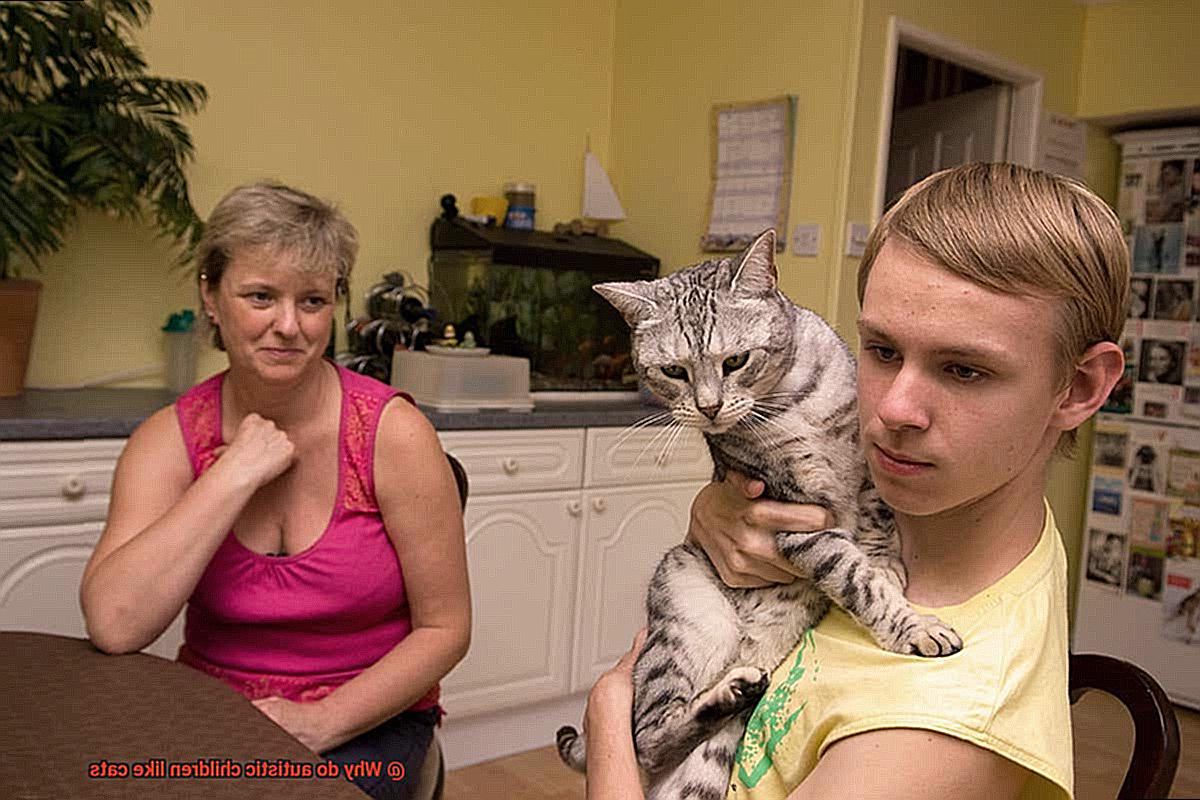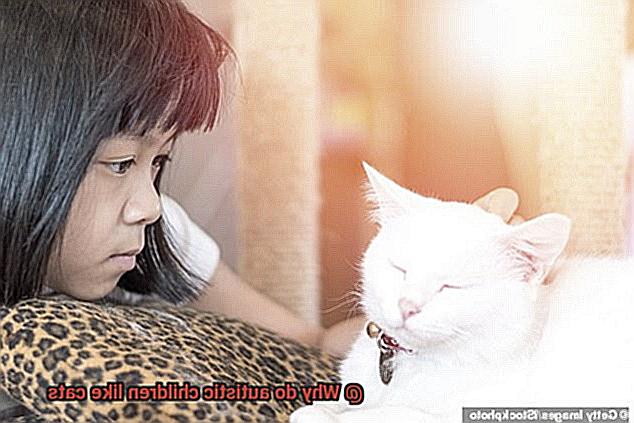Have you ever noticed how many autistic children seem to have an unexplainable love for cats? It’s a fascinating phenomenon that has both intrigued and confounded scientists and parents alike for years. As someone who spends a lot of time with autistic children, I’ve witnessed firsthand the joy and calm that overcomes them when they’re around feline friends. It’s truly a beautiful thing to behold, and it begs the question: what is it about cats that draws autistic children to them?
One theory suggests that it’s because cats are predictable creatures. Autistic children often crave routine and structure, and the predictability of feline behavior can provide a sense of comfort and security. Additionally, some believe that the tactile stimulation of petting a cat can be soothing for autistic children, who may struggle with sensory processing.
Furthermore, cats are non-judgmental creatures. They don’t expect social interaction or engagement, which can be a relief for autistic children who may find social situations overwhelming. They can simply be with their furry companion, enjoying their company without feeling pressured to communicate or perform.
Regardless of the reason behind this special bond between autistic kids and cats, there’s no denying its power. It’s a testament to the healing abilities of animals and the innate connection we share with them. So next time you see an autistic child snuggled up with their kitty pal, take note of the magic happening before your eyes – it’s truly something special.
What is Autism?
Autism Spectrum Disorder (ASD), commonly referred to as autism, is a complex neurodevelopmental disorder that affects communication, social interaction, and behavior. It is called a “spectrum” disorder because it affects individuals differently and to varying degrees. While the exact cause of autism is unknown, experts believe that it is a combination of genetic and environmental factors.
Early Intervention is Key
Autism can be diagnosed as early as 18 months old, and early intervention can significantly improve outcomes for individuals with autism. Symptoms of autism may include delayed or impaired language development, difficulty with social interactions, repetitive behaviors or interests, sensory sensitivities, and difficulty with nonverbal communication.
Management through Therapies and Interventions
Autism is not a disease or an illness that can be cured, but it is a condition that can be managed through various therapies and interventions. These may include behavioral therapies, speech therapy, occupational therapy, and medication.
Uniqueness of Individuals with Autism
It’s important to note that individuals with autism are unique, and their experiences may vary widely. Some may have exceptional talents in certain areas, such as math or music, while others may struggle with day-to-day tasks. Understanding and acceptance of individuals with autism is key to creating an inclusive society where everyone can thrive.
The Special Connection between Autistic Children and Cats
For children with autism, forming relationships with others can be difficult. However, research has shown that many autistic children have a special connection with animals, particularly cats. There are several reasons for this.
Firstly, cats are predictable creatures that follow routines and are not prone to sudden outbursts or changes in mood. This predictability can be comforting for autistic children who thrive on routine and familiarity.
Secondly, cats are non-judgmental and do not require the same level of social interaction as humans. Autistic children may struggle with social cues and body language, but cats communicate in a different way that is easier for them to understand. They also don’t judge or criticize, providing a sense of security and acceptance that may be lacking in other relationships.
Furthermore, cats offer unconditional love and acceptance without expecting anything in return. This can be especially important for autistic children who may feel misunderstood or rejected by their peers. The bond between an autistic child and their cat can be incredibly strong, offering emotional support that is difficult to find elsewhere.
Why Autistic Children are Drawn to Cats
It’s a bond that goes beyond the simple joy of having a pet and delves deep into the therapeutic realm. In this post, I will delve into why autistic children are drawn to cats.
Firstly, cats are quiet and non-threatening animals, making them particularly appealing to autistic children who may have difficulty processing sensory information. Sudden movements and loud noises can be overwhelming for these children. Cats’ graceful movements and calm demeanor offer a soothing presence that can help calm these children’s anxiety.
Secondly, cats are independent creatures that do not require constant attention or interaction. This can be beneficial for autistic children who may prefer solitary activities and find it challenging to engage in social interactions. Cats provide companionship without the pressure of socializing or communicating in a traditional way.
Thirdly, cats offer a sense of routine and predictability. They follow a set schedule for feeding, sleeping, and playing. Children with autism thrive on structure and routine, making cats ideal companions. The predictability of cats’ behavior can help autistic children feel more secure and grounded.
Finally, cats offer unconditional love and acceptance. They do not judge or criticize, making them ideal companions for children who may struggle with social cues or feel misunderstood by others. The simple act of petting a cat can release endorphins and provide a sense of calmness and comfort for autistic children.
Predictability of Cats
Autistic children often thrive on routines and predictability in their daily lives, and cats offer precisely that. These graceful creatures follow their own schedules, from sleeping in the same spot to grooming themselves at certain times of the day. This predictability can provide a sense of security and comfort for autistic children.
But that’s not all. Cats are relatively low-maintenance pets that don’t require constant attention or interaction. They can be independent and self-sufficient, which may appeal to kids who struggle with social interactions or communication. Imagine having a pet that doesn’t demand your attention all the time but is always there when you need them.
Additionally, cats’ body language is often subtle and non-threatening, making them less intimidating than other pets like dogs. Autistic children may find it easier to read their emotions and understand their behavior, which can help them feel more confident and comfortable around animals.
In summary, the predictability and low-maintenance nature of cats make them an excellent choice for autistic children. Here are some specific reasons why:
- Consistent behavior: Cats follow routines and habits, offering a sense of security and comfort for autistic children.
- Low-maintenance: Cats are independent and self-sufficient, making them an ideal pet for kids who struggle with social interactions or communication.
- Subtle body language: Cats’ non-threatening body language is easy for autistic children to read and understand.
Non-Judgmental Nature of Cats
Cats are some of the most non-judgmental creatures around. They don’t care if you’re having a bad hair day, if you’ve made mistakes in the past, or if you struggle with social interactions. This non-judgmental nature is particularly beneficial for autistic children, who may feel misunderstood and overwhelmed in social situations.

Autistic children can be themselves around cats without fear of criticism or rejection. Cats offer unconditional love and acceptance, which is incredibly comforting for children who may feel like they don’t fit in. The simple act of curling up in a cat’s lap and feeling their gentle purring can be a soothing balm for an anxious child.
In addition to their non-judgmental nature, cats are predictable creatures with regular routines and behaviors. For autistic children who thrive on structure and routine, this predictability can provide a sense of security and stability. The familiar behaviors of cats, such as grooming and sleeping, can be a reassuring presence in a child’s life.
But perhaps the most important thing that cats offer autistic children is a calming presence. Cats are known for their ability to reduce anxiety and stress. Their soft fur and gentle purring can be incredibly soothing for children who may be feeling overwhelmed by the sensory overload of the world around them.
Unconditional Love of Cats
As someone who has studied the topic of unconditional love of cats, I have discovered that their special qualities provide a sense of comfort, stability, and emotional support for autistic children. Here are some ways in which cats can be a valuable companion for children with autism.
Firstly, cats are known for their ability to offer companionship without judgment or expectations. For children who may struggle with social interaction and expressing emotions, cats can be a calming presence in their lives. The simple act of petting and cuddling a cat can provide a sense of comfort and security that is hard to find elsewhere.
In addition, cats thrive on routine and consistency. They have set schedules for eating, sleeping, and playing, which can be very soothing for children with autism who thrive on predictability. Having a cat as a companion can help an autistic child feel more in control and grounded in their daily life.
Furthermore, cats are non-verbal creatures and communicate through body language, facial expressions, and vocalizations. This type of communication is easier for autistic children to understand as they often struggle with verbal communication. By spending time with a cat, an autistic child can learn to interpret these non-verbal cues and develop important social skills.
Cats are also very affectionate creatures that enjoy physical touch. They seek out their human companions for cuddles and pets, which can be very comforting for autistic children who may struggle with physical contact. The gentle purring of a cat can also have a calming effect on children with autism.

The bond between an autistic child and their cat can be incredibly strong and beneficial for both the child and the animal. The unconditional love of cats provides a unique source of comfort and support for autistic children by offering companionship without judgment or expectations; providing routine and consistency; communicating non-verbally; and offering affection through physical touch.
Sensory Stimulation from Cats

The unique way cats interact with their environment can be very appealing to those seeking sensory input. The soft fur, gentle purring, and graceful movements of a cat can provide a calming and soothing experience that can help reduce anxiety levels.
Cats also provide a sense of predictability and routine which can be comforting for children on the autism spectrum who often struggle with changes in their environment and schedule. The routine of feeding, grooming, and playing with a cat can create structure in an otherwise unpredictable world, leading to increased feelings of safety and security.
In addition to providing sensory stimulation and routine, cats also offer companionship without the pressure of social interaction. This is especially important for many children with autism who find social interactions overwhelming. Cats do not require verbal communication or eye contact, yet they still offer unconditional love and affection.

Research has shown that pet therapy, including interactions with cats, can have a positive impact on individuals with autism. Pet therapy has been found to improve social skills, reduce anxiety levels and increase overall well-being.
So if you’re looking for ways to improve your child’s quality of life, consider introducing them to a furry feline friend. Here are some reasons why:
- Sensory stimulation: The soft fur, gentle purring and graceful movements of the cat can provide a calming and soothing experience that can help reduce anxiety levels.
- Routine: The routine of feeding, grooming, and playing with a cat can create structure in an otherwise unpredictable world.
- Companionship: Cats offer companionship without the pressure of social interaction that can be overwhelming for children with autism.
- Positive impact: Research has shown that pet therapy can have a positive impact on individuals with autism.

Benefits of Having a Cat for Autistic Children
Beyond providing a source of companionship and comfort, cats offer a variety of advantages that can positively impact a child’s physical and emotional well-being. In this blog post, I will explore the ways in which owning a cat can be particularly beneficial for autistic children.
Foremost, cats can help alleviate stress and anxiety levels in children with autism. As social communication can be challenging for these children, cats can provide a calming presence and reduce feelings of loneliness. This, in turn, can enhance their self-esteem and confidence in social situations.
In addition to reducing stress and anxiety levels, cats can also improve sensory processing in autistic children. Many autistic children struggle with sensory processing issues, but petting or playing with a cat can help regulate their sensory systems. Furthermore, some children find the sound of a cat’s purring to be soothing and comforting.
Moreover, caring for a pet cat can teach autistic children responsibility and empathy. By having a pet to care for, they learn important life skills and develop daily routines. Caring for a cat also creates opportunities for social interaction and communication with others.

In summary, owning a cat can offer numerous benefits for children on the autism spectrum. Here are some of the main advantages:
- Reduced stress and anxiety levels
- Improved sensory processing
- Enhanced self-esteem and confidence in social situations
- Teaching responsibility and empathy
- Creating opportunities for social interaction and communication

Tips for Introducing a Cat to an Autistic Child
Introducing a Cat to an Autistic Child: Tips and Tricks
Bringing a new pet into your home can be an exciting experience, but it can also be stressful for both the child and the animal. This is especially true when it comes to introducing a cat to an autistic child. However, with some tips and tricks, this process can be made easier and more comfortable for both parties.
Start Slowly
When introducing a cat to an autistic child, it’s important to take things slowly. Begin by allowing your child to observe the cat from a distance. This could involve showing them pictures or videos of cats, or simply allowing them to watch the cat from across the room.
By taking things slowly, you can help your child become more familiar and comfortable with the cat’s presence before moving on to more direct interactions.

Positive Interactions
Providing your child with plenty of opportunities for positive interactions with the cat is crucial. This could involve playing with toys together or providing treats for the cat when the child is nearby.
These positive interactions can help build a sense of trust and comfort between the child and the cat, making it easier for them to form a bond over time.

Teach Proper Care
Teaching your child about proper cat care and handling is essential. This includes how to approach and pet the cat gently, as well as how to feed and care for them.
By educating your child about proper cat care, you can help build a sense of responsibility and ownership over their new furry friend.
Supervise Interaction
As your child becomes more comfortable around the cat, it’s important to supervise any direct interaction between them closely. This can involve sitting with them while they play with the cat or feeding the cat together.
By supervising these interactions closely, you can ensure that both your child and the cat remain safe and comfortable around each other.
Create a Safe Space
Creating a safe space for both your child and the cat is essential. This could involve setting up a designated area for the cat away from the child’s play area, or providing a hiding spot for the cat when they need some alone time.
By creating a safe space for both parties, you can help ensure that your child and their new furry friend have a positive and comfortable relationship.
Conclusion
The bond between autistic children and cats is a captivating phenomenon that has intrigued scientists and parents alike for years. The predictability of feline behavior can provide a sense of comfort and security for autistic children, who often crave routine and structure. Furthermore, cats are non-judgmental creatures that do not expect social interaction or engagement, which can be a relief for autistic children who may find social situations overwhelming.
Cats offer sensory stimulation through their soft fur, gentle purring, and graceful movements, which can be calming and soothing for children with autism who struggle with sensory processing. Additionally, caring for a pet cat can teach autistic children responsibility and empathy while creating opportunities for social interaction and communication.
However, introducing a cat to an autistic child requires patience and positive interactions to build trust and comfort between them. It’s crucial to take things slowly, provide plenty of opportunities for positive interactions, teach proper care, supervise interactions closely, and create a safe space for both parties.
In conclusion, the bond between autistic children and cats is a testament to the healing abilities of animals and the innate connection we share with them. As such, introducing a furry feline friend into an autistic child’s life could offer numerous benefits that positively impact their physical and emotional well-being.







